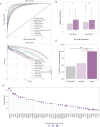This is a preprint.
Regulatory risk loci link disrupted androgen response to pathophysiology of Polycystic Ovary Syndrome
- PMID: 40196246
- PMCID: PMC11974941
- DOI: 10.1101/2025.03.26.25324630
Regulatory risk loci link disrupted androgen response to pathophysiology of Polycystic Ovary Syndrome
Abstract
A major challenge in deciphering the complex genetic landscape of Polycystic Ovary Syndrome (PCOS) lies in the limited understanding of how susceptibility loci drive molecular mechanisms across diverse phenotypes. To address this, we integrated molecular and epigenomic annotations from proposed causal cell-types and employed a deep learning (DL) framework to predict cell-type-specific regulatory effects of PCOS risk variants. Our analysis revealed that these variants affect key transcription factor (TF) binding sites, including NR4A1/2, NHLH2, FOXA1, and WT1, which regulate gonadotropin signaling, folliculogenesis, and steroidogenesis across brain and endocrine cell-types. The DL model, which showed strong concordance with reporter assay data, identified enhancer-disrupting activity in approximately 20% of risk variants. Notably, many of these variants disrupt TFs involved in androgen-mediated signaling, providing molecular insights into hyperandrogenemia in PCOS. Variants prioritized by the model were more pleiotropic and exerted stronger downregulatory effects on gene expression compared to other risk variants. Using the IRX3-FTO locus as a case study, we demonstrate how regulatory disruptions in tissues such as the fetal brain, pancreas, adipocytes, and endothelial cells may link obesity-associated mechanisms to PCOS pathogenesis via neuronal development, metabolic dysfunction, and impaired folliculogenesis. Collectively, our findings highlight the utility of integrating DL models with epigenomic data to uncover disease-relevant variants, reveal cross-tissue regulatory effects, and refine mechanistic understanding of PCOS.
Keywords: Polycystic Ovary Syndrome (PCOS); artificial intelligence; deep learning; disease-causal noncoding variants; enhancer variants; regulatory genomics.
Figures




Similar articles
-
Targeted inhibition of kisspeptin neurons reverses hyperandrogenemia and abnormal hyperactive LH secretion in a preclinical mouse model of polycystic ovary syndrome.Hum Reprod. 2024 Sep 1;39(9):2089-2103. doi: 10.1093/humrep/deae153. Hum Reprod. 2024. PMID: 38978296 Free PMC article.
-
Bidirectional Mendelian randomization to explore the causal relationships between body mass index and polycystic ovary syndrome.Hum Reprod. 2019 Jan 1;34(1):127-136. doi: 10.1093/humrep/dey343. Hum Reprod. 2019. PMID: 30496407 Free PMC article.
-
POLYCYSTIC OVARY SYNDROME: ORIGINS AND IMPLICATIONS: Polycystic ovary syndrome: the impact of androgen excess on metabolic health.Reproduction. 2025 Jul 4;170(2):e250102. doi: 10.1530/REP-25-0102. Print 2025 Aug 1. Reproduction. 2025. PMID: 40548832 Review.
-
Insulin-sensitising drugs (metformin, rosiglitazone, pioglitazone, D-chiro-inositol) for women with polycystic ovary syndrome, oligo amenorrhoea and subfertility.Cochrane Database Syst Rev. 2017 Nov 29;11(11):CD003053. doi: 10.1002/14651858.CD003053.pub6. Cochrane Database Syst Rev. 2017. PMID: 29183107 Free PMC article.
-
Ovarian surgery for symptom relief in women with polycystic ovary syndrome.Cochrane Database Syst Rev. 2017 Nov 10;11(11):CD009526. doi: 10.1002/14651858.CD009526.pub2. Cochrane Database Syst Rev. 2017. PMID: 29125183 Free PMC article.
References
-
- Joham AE, Norman RJ, Stener-Victorin E, Legro RS, Franks S, Moran LJ, et al. Polycystic ovary syndrome. Lancet Diabetes Endocrinol. 2022. Sep 1;10(9):668–80. - PubMed
-
- Palomba S, Piltonen TT, Giudice LC. Endometrial function in women with polycystic ovary syndrome: a comprehensive review. Hum Reprod Update. 2021. Apr 21;27(3):584–618. - PubMed
-
- Stener-Victorin E, Teede H, Norman RJ, Legro R, Goodarzi MO, Dokras A, et al. Polycystic ovary syndrome. Nat Rev Dis Primer. 2024. Apr 18;10(1):1–23. - PubMed
Publication types
LinkOut - more resources
Full Text Sources
Miscellaneous
